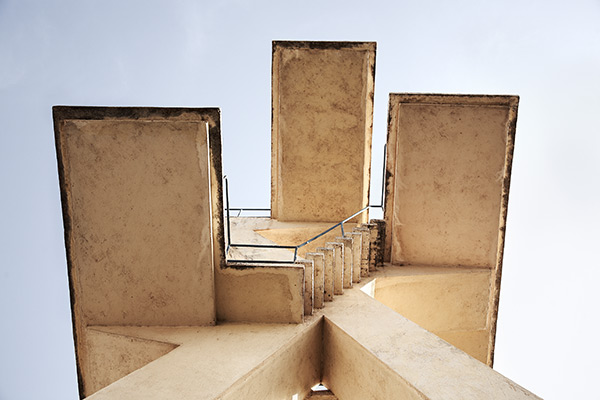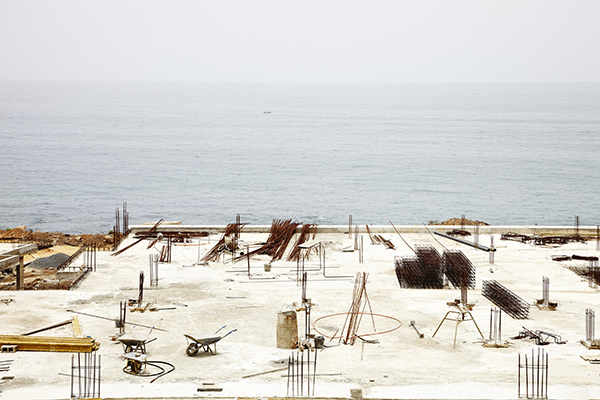Armory Africa Focus Preview: A Conversation with François-Xavier Gbré

François-Xavier Gbré, Swimming pool III, Bamako, 2009. Courtesy the artist and Galerie Cécile Fakhoury, Abidjan
Working in France and West Africa, François-Xavier Gbré studies the ruins of industry, modernist architecture, and national memorials. Here, the Ivorian photographer, whose latest work will be featured in the Armory Show’s Focus: African Perspectives, speaks with Peter Barberie, the Brodsky Curator of Photographs at the Philadelphia Museum of Art.
Peter Barberie: You have photographed ruined modernist buildings in both Europe and Africa. How are these disparate sites connected for you? It seems to me that your photographs capture the aspirations of these buildings, as well as their failings.
François-Xavier Gbré: I grew up in the north of France, an area that used to be an industrial center. In the 1970s and ’80s, the region was in decline and abandoned factories surrounded us. The aesthetic became familiar and it came out in my work. The Unilever factory in Haubourdin and Poyaud in Surgères were both built in the early twentieth century. The modernist architecture was a symbol of rapid technological advancement and modernization of society. European architects naturally exported their model during the colonial time and after. In my work, I look for bridges between Europe and Africa. I try to document the complex relationship between North and South. Even if these buildings were constructed for different reasons, they often share the same fate (for different reasons, too).

François-Xavier Gbré, Unilever II, Haubourdin, France, 2010. Courtesy the artist and Galerie Cécile Fakhoury, Abidjan
Barberie: Your photographs of the Imprimerie Nationale, in Porto Novo, Benin, are especially moving to me. When I visited Rencontres de Bamako–The African Biennale of Photography in November 2015, I encountered several conversations about the loss of modern African archives, so it seems to me that the history of several African nations is at stake in these pictures. Were you thinking about archives when you made these views?
Gbré: All of the chapters of my series Tracks (2009–2015) aim to acknowledge the past. In this way, I make an archive. The Imprimerie Nationale (National Printing Factory) is more particular because I documented a place in charge of the official documentation of an African state. And the conclusion is sad. This chapter of my work includes both a question and an answer: Why don’t we have a better understanding or recognition of African history? Because African archives are in a mediocre state.

François-Xavier Gbré, Piscine #1, Université Félix Houphouët-Boigny, Cocody, Abidjan, 2014. Courtesy the artist and Galerie Cécile Fakhoury, Abidjan
Barberie: I am curious about swimming pools as a recurring motif for you. I think this tells us about an important element in your work. You approach these sites with an eye that is both critical and optimistic.
Gbré: As a child, I used to go to the public swimming pool and it made my day. And I still love it. After showing my work about the swimming pool in Bamako, many friendly people wanted to introduce me to other pools, but I didn’t have any particular interest in it because I was not making an inventory. I use that motif because it can tell a lot about the society. In Bamako, I question the construction and the succession. The absence of water implies the idea of death. In Abidjan, the pool is filled, but it appears very quiet, despite the fact that it’s located on the university campus. Why there is such a silence? What are people waiting for? What are people dreaming of?

François-Xavier Gbré, Général Abdoulaye Soumaré, Avenue des Armées, Sotuba, Bamako, 2013. Courtesy the artist and Galerie Cécile Fakhoury, Abidjan
Barberie: Your photographs of the sculptures on the Avenue des Armées in Bamako grapple with a more brutal topic, military might. The sculptures look small in your pictures, which dwell upon the unfinished state and questionable impact of this triumphal avenue. To some degree you treat the place with comedy. During Rencontres de Bamako you exhibited large cutout prints of some of the sculptures in a space next to Bla Bla Bar, one of the key meeting points in the city. The way you installed and lit the pictures was incredible: they looked like remnants of sculpture from the Parthenon. The comedy was gone, replaced by pathos and menace. In the past you have installed wallpaper prints in several locations, including Bla Bla. Was this the first time you exhibited prints that were shaped and melded into the setting?

François-Xavier Gbré, Installation view from the series Mali Militari, Hippodrome, Rencontres de Bamako, October 2015. Courtesy the artist and Galerie Cécile Fakhoury, Abidjan
Gbré: In 2013, I discovered this new part of the Bla Bla when I was still living in Bamako, and since the first look I wanted to do something in it. In October 2015, I came back to Bamako with a “precise” project in mind and I was very surprised when I found that place totally changed: almost all the walls were destroyed. That pushed me to experiment with a new way of showing my work in order to fit the original idea of the project. The idea was to build my own square by bringing sculptures from one area of Bamako to another. I wanted to translocate the statues from an open space to a closed one, creating a more intimate reading of the work. I wanted to concentrate the several architectural elements from Avenue des Armées in order to share the experience and the feelings I had when taking the photographs years before. By repeating and multiplying the sculptures, playing with their size in the installation, I could make the message more impressive or aggressive. The lighting also played an important role by night. Finally, the fact that the original place was destroyed facilitated the dialogue between the location and the artworks because now they would share the same aesthetic of construction and destruction. It was the first time I worked in that way. The surprise makes the work in situ more exciting to me.

François-Xavier Gbré, Baie de Mermoz II, Dakar, Senegal, 2012. Courtesy the artist and Galerie Cécile Fakhoury, Abidjan
Barberie: Your photograph Baie de Mermoz II gives us an expansive view foregrounded by a construction site where work seems to have just begun. This composition, like many of your others, has real elegance. I’ve never been to Dakar, so I googled “Baie de Mermoz” to learn more about the place. The top results were all about real estate!
Gbré: This photograph deals with how the private space imposes itself with force into the public landscape. I see art as an act of showing a political or social issue in its most beautiful dress.
François-Xavier Gbré’s work will be on view at the Armory Focus: African Perspectives in New York from March 3–6, 2016.






















